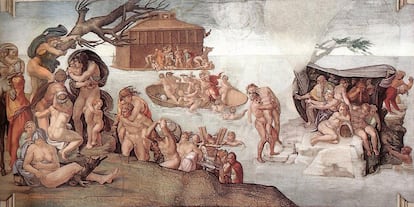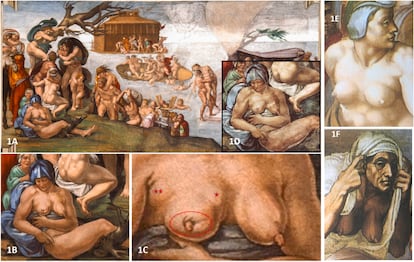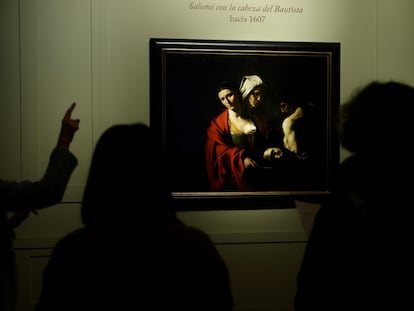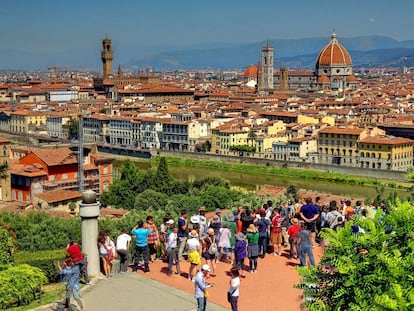Michelangelo’s secret ‘code’: Did the master conceal a medical treatise in his artworks?
A new study by the University of Paris-Saclay suggests that the scene of ‘The Flood’ in the Sistine Chapel frescoes depicts a woman with signs of breast cancer

To achieve the level of anatomical perfection that Michelangelo Buonarroti achieved in his works, such as the frescoes in the Sistine Chapel, great artistic talent is required. But even this is not enough if it is not supported by a deep knowledge of anatomy. And in addition to using models, which is common for artists, Michelangelo had another, more unusual source of anatomical information: his dissections of corpses. Although he did not publish the anatomy treatise that he had in mind, perhaps in a way he did: several studies claim that his works contain the representation of diseases and undercover anatomy lessons, all of it with a supposed symbolism.
In a recent study, a team of European researchers led by Rafaella Bianucci of the University of Paris-Saclay proposes that the scene from The Flood in the Sistine Chapel frescoes shows a woman with signs of cancer on her right breast: a deformed and retracted nipple, a misshapen areola, a bulging area, and possible nodules in the armpit. These are “features consistent with breast carcinoma,” Bianucci and colleagues write.

The team led by Bianucci includes experts in art history, medicine, genetics and pathology who have specialized in so-called iconodiagnosis, the diagnosis of diseases in figures represented in works of art. The researchers previously published a series of guidelines and recommendations to establish a rigorous methodology when seeking evidence for these diagnoses: from IV, “impossible,” to I, “certain or almost certain.”
According to Andreas Nerlich, a pathologist at Ludwig-Maximilians-University in Munich and first author of the new study, “the essential point is that external influences on the image are excluded, and historical and artistic influences are clearly included and identified in the interpretation.”
The latter implies that it is not just a matter of appreciating the signs of the disease, but that the level of evidence grows when they are placed in a significant symbolic context. Michelangelo painted a group of people condemned to die in the biblical flood depicted in the Book of Genesis as punishment for their sins.

“The representation of a probable breast cancer is linked to the concept of the impermanence of life and has the significance of punishment,” the authors write; the fresco depicts the capital sins and, for Michelangelo’s strict religious mentality and the prejudices of the time, “perhaps breast cancer may represent a personal punishment for lust (?).” The woman is pointing to the ground, which the authors link to a quote from Genesis: “For dust you are and to dust you shall return.”
Nerlich points out that this is not the only occasion on which the artist may have represented this disease: “In a previous work on Michelangelo’s sculptures in the Medici chapels in Florence, evidence of the representation of breast cancer was identified in the figure of Night,” something that in that statue could allude to inevitable mortality.
‘Easter eggs’ with symbolic content
Michelangelo’s work has been associated with the intricacies of human anatomy and its diseases since 1990, when the doctor and amateur artist Frank Meshberger described the surprising resemblance of God’s cloak in the scene of the creation of Adam, perhaps the best known and most reproduced in the Sistine Chapel, to a human brain. It is not a question of diagnosing a character, but of a hidden drawing, in the style of what in today’s audiovisual media jargon we would call an Easter Egg. But as in the case of illness, what provides credibility is also the symbolism: Meshberger believed that “Michelangelo encoded a special message. It is a message consistent with thoughts he expressed in his sonnets”; “He believed that the ‘divine part’ we ‘receive’ from God is the ‘intellect.’”
However, there are alternative theories: in the same drawing, a group of Italian researchers saw something different, a postpartum uterus, which for these authors symbolizes the birth of humanity. Another case of dissenting visions is the strange volumes of the neck of the figure of God in another scene, The Separation of Light from Darkness. Here the doctors Lennart Bondeson and Anne-Greth Bondeson visualized a goiter, a thyroid disease that could have affected Michelangelo himself, who according to the Bondesons in this way “‘signed’ his massive achievement — a backbreaking fresco of nearly six thousand square feet — by incorporating himself as an embodiment of the Supreme Creator in the final panel to be painted, the Separation of Light from Darkness.”
It would not be the only time that the artist was able to capture his own ailments: the nephrologist Garabed Eknoyan saw in the mantle of God in another scene, the Separation of the Earth from the Waters, the image of a kidney, which could refer to the kidney stones that the artist suffered from and, in addition, would symbolize the separation of solids and liquids attributed at that time to this organ. But in the alleged goiter described by the Bondesons, Ian Suk and Rafael Tamargo saw something quite different: a sketch of the brain stem, with its spinal cord and optic nerve.

But did Michelangelo really intend to depict everything that today’s researchers see in his work? “It’s a difficult question,” Eknoyan answers. What is certain is that he had advanced anatomical erudition born from his dissections, which he began to practice at a very young age in the convent of Santo Spirito, after the death in 1492 of his patron, Lorenzo de Medici. His disciple and biographer Ascanio Condivi wrote about his master’s passion for this practice, which he pursued until an advanced age. According to Condivi, Michelangelo knew details that the doctors of his time did not. But his project to illustrate an anatomical treatise by his friend and doctor, Realdo Colombo, never came to fruition.
As Eknoyan admits, “the interpretation of any painting by a viewer is relatively speculative.” The nephrologist says he had visited the Sistine Chapel at least three times without ever seeing the shape of a kidney. The image came to him at home when he saw an illustration of the scene. “When I suddenly perceived the shape of the kidney, I couldn’t get it out of my head.”
Sign up for our weekly newsletter to get more English-language news coverage from EL PAÍS USA Edition
Tu suscripción se está usando en otro dispositivo
¿Quieres añadir otro usuario a tu suscripción?
Si continúas leyendo en este dispositivo, no se podrá leer en el otro.
FlechaTu suscripción se está usando en otro dispositivo y solo puedes acceder a EL PAÍS desde un dispositivo a la vez.
Si quieres compartir tu cuenta, cambia tu suscripción a la modalidad Premium, así podrás añadir otro usuario. Cada uno accederá con su propia cuenta de email, lo que os permitirá personalizar vuestra experiencia en EL PAÍS.
¿Tienes una suscripción de empresa? Accede aquí para contratar más cuentas.
En el caso de no saber quién está usando tu cuenta, te recomendamos cambiar tu contraseña aquí.
Si decides continuar compartiendo tu cuenta, este mensaje se mostrará en tu dispositivo y en el de la otra persona que está usando tu cuenta de forma indefinida, afectando a tu experiencia de lectura. Puedes consultar aquí los términos y condiciones de la suscripción digital.
More information
Archived In
Últimas noticias
There is as much life left to discover on planet Earth as that which is already known
Dozens presumed dead, around 100 injured in fire at Swiss Alps bar during New Year’s celebration
Is porn for women different from conventional porn? We spoke to those who make it
Cartagena de Indias is sinking: What can the city do to mitigate it?
Most viewed
- David King, chemist: ‘There are scientists studying how to cool the planet; nobody should stop these experiments from happening’
- Reinhard Genzel, Nobel laureate in physics: ‘One-minute videos will never give you the truth’
- Oona Chaplin: ‘I told James Cameron that I was living in a treehouse and starting a permaculture project with a friend’
- Sinaloa Cartel war is taking its toll on Los Chapitos
- The Interoceanic Train, the Mexican alternative to the Panama Canal










































